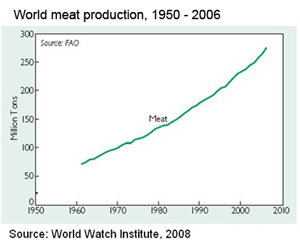In the futuristic dystopia of Margaret Atwood’s novel Oryx and Crake, real farm animals are a rare luxury, and meat is industrially produced with genetically engineered growth units. Characters tuck into ChickieNobs’ Bucket’o’Nubbins, and at one point they encounter the creature from which said nubbins are grown. It’s described as “a large bulblike object… out of it came twenty thick fleshy tubes, and at the end of each tube another bulb was growing.” There’s an opening at the top of the central bulb so that nutrients can be pumped in, but it has no beak or eyes – it’s a food-optimised pseudo-chicken.
This rather freakish image came to mind this week, as synthetically grown meat was back in the news. A team in the Netherlands is planning to serve the first lab-grown burger later this year, and they want Heston Blumenthal to cook it.
Needless to say it’s nothing like Atwood’s creation. The burger will be composed of thousands of shreds of beef muscle grown from bovine stem cells. Neither is it industrial production for the masses – that one burger will cost over £200,000. We’re a long way from cheap synthetic beef products, and this is a ‘proof of concept’ exercise. If it’s successful, no doubt the stunt will draw in the kind of funding the project would need to make commercial sense.
 But why would you bother in the first place? What’s wrong with an actual cow? The main reason why you might want to grow meat in a lab is that global demand for meat is growing rapidly. Countries that have traditionally eaten very little meat are increasing their consumption, and the emerging middle classes of the developing world are embracing a more Western diet, for better or worse.
But why would you bother in the first place? What’s wrong with an actual cow? The main reason why you might want to grow meat in a lab is that global demand for meat is growing rapidly. Countries that have traditionally eaten very little meat are increasing their consumption, and the emerging middle classes of the developing world are embracing a more Western diet, for better or worse.
That increase in production has already had a serious environmental impact. Cattle ranching is the primary cause of deforestation in the Amazon, and ‘bovine emissions’ are a serious contributor to climate change. Depending on who you ask, methane emissions from lifestock may be a bigger polluter than cars.
Delivering the quantities of meat that we need has an impact on animal welfare. Industrial farms produce feedlot cattle, pigs that can’t turn round in their tiny pens, and battery chickens. These intensive techniques have consequences for human health too, as diseases can mutate quickly in the cramped conditions and spawn new varieties, and the case of bird flu has shown.
Synthentic meat would solve many of these problems. A tiny handful of animals would have to die to provide the stem cells, so the animal welfare issue is solved. It would be created under controlled conditions and could be tailor-made with a specific fat content, so it might actually be healthier. Emissions would be low and the rainforest would remain. What’s not to like, presuming it actually tastes like beef?
And it doesn’t just have to be beef, either. You can create any meat this way, which might take the pressure off some of the species currently being hunted to extinction, like tuna. “I’m pretty sure you could even make panda meat” says Dr Mark Post.
I think the biggest obstacle to lab-grown meat is public perception. People don’t like the idea, it’s weird and unnatural. But then food is like that, full of arbitrary rules about what it’s okay to eat, and what’s disgusting. We eat prawns, but not insects. You can eat endangered Swordfish, but people would be horrified if you fried up a common goldfish. And of course it’s cultural. French cooking is a tradition refined over centuries, and the English have been cultivating their disgust at much of it for just as long. Cultures and perceptions can change, and that’s presumably why this latest venture is in the news. With a bit of smart PR, when synthetic meat goes on sale, people will think of Heston Blumenthal and not ChickieNobs’ Bucket’o’Nubbins.
Of course, synthetic meat is one answer to the problem of meat demand, and it’s a market response. I’ve got a simpler and better solution to our meat overconsumption. We could, perhaps, just eat less of it.

“I think the biggest obstacle to lab-grown meat is public perception.”
Yes, this is it in a nutshell. When I first heard about synthetic meat a few years back, I couldn’t get over how great an idea it was. But whenever I talked about it with my friends who don’t have a background in lab work/science, they couldn’t get over how weird it was. It makes perfect sense to me — you have meat that’s been grown in a sterile enviroment, without the issues of animal cruelty, and you can even control the fat content of your meat! Amazing! But to most people it’s too frankenstein-in-a-bun. I really hope that we’ll be able to change public perception about this in the future, but maybe I’m a tad too idealistic.
http://www.cbc.ca/quirks/episode/2009/03/28/nine-and-a-half-technologies-that-could-change-the-world/ very cool podcast that looked at in vitro meat a while back.
Well if necessity is the mother of invention, surely the space on earth that animals take will contribute to the matter, then of course, if manufactured meat becomes cost efficient, will we bring all the animals we eat into the Red Data Book and make them under threat or even extinct? Probably, after all the world is ours isn’t it!!! Whose?
Ultimately of course, this leads to the world populated by humans, with some laboratories making tablets – how beautiful and full of love. (Don’t laugh).
Associated problem- oxygen. Answer – bubbles with machines. Any more ideas?